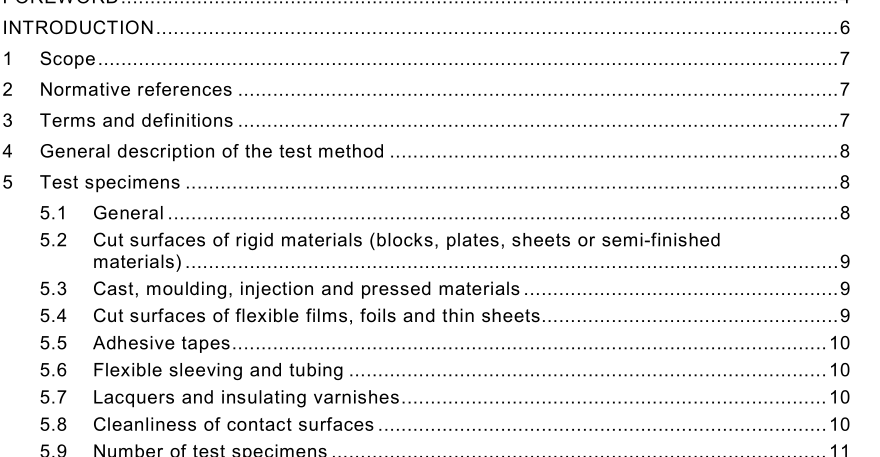IEC 60426-2007 pdf Electrical insulating materials – Determination of electrolytic corrosion caused by insulating materials – Test methods

5.5 Adhesive tapes For adhesive tapes the method of Clause 7 of IEC 60454-2 is recommended. 5.6 Flexible sleeving and tubing Sleeving and tubing (both varnished fabric and extruded) are slit open, so as to make flat sheets, which can then be prepared as for films (see 5.4). 5.7 Lacquers and insulating varnishes The lacquer or insulating varnish to be tested shall be applied in the manner recommended by the manufacturer to the surface of a test specimen of shape as shown in Figure 1 and described in 5.2. The base material of the test specimen shall be a corrosion free plastic such as polymethylmethacrylate. In case of solvent incompatibility or a baking temperature being too high for the base material, another suitable base material such as cast, hot cured corrosion free epoxy resin or glass shall be used. If the lacquer or insulating varnish is designed to contribute freedom from corrosion to another material, a test specimen of that material shall be used. The tested lacquer or varnish shall be sprayed, dipped or otherwise coated to the desired thickness and baked, if necessary, as specified or according to the directions of the manufacturer. If the thickness of coating is not determined by specification or direction of the manufacturer, it shall be of (30 ± 1 0) μm. 5.8 Cleanliness of contact surfaces When preparing and handling the test specimens, any soiling of the test surfaces, for example by perspiration from the hands, shall be avoided. The specimens shall be touched only with a pair of tweezers or with protecting gloves made of materials free from corrosion (e.g. polyethylene). After the test specimens have been machined or cut, their surfaces shall be cleaned with a soft brush.
5.9 Number of test specimens At least five test specimens made from the same material shall be tested at the same time. A specific sampling procedure may be desired. If necessary, such a sampling procedure should be specified and used. 6 Test strips 6.1 General The test strips shall be made of 0,1 mm thick, semi-hard copper of purity 99,9 Cu. Their dimensions are 1 0 mm wide and 200 mm long. The test strips shall be flat, without bends and burrs at the edges as well as any other mechanical defects or impurities on the test surface, which may have influence on the test results.
- Previous:IEC 60587-2007 pdf Electrical insulating materials used under severe ambient conditions – Test methods for evaluating resistance to tracking and erosion
- Next:IEC 60358-3-2013 pdf Coupling capacitors and capacitor dividers – Part 3: AC or DC coupling capacitor for harmonic-filters applications
- ISO IEC 27050-4-2021 pdf Information technology — Electronic discovery — Part 4: Technical readiness
- ISO IEC 27036-1-2021 pdf Cybersecurity — Supplier relationships — Part 1: Overview and concepts
- ISO IEC 27013-2021 pdf Information security, cybersecurity and privacy protection — Guidance on the integrated implementation of ISO/IEC 27001 and ISO/IEC 20000-1
- ISO IEC 26580-2021 pdf Software and systems engineering — Methods and tools for the feature- based approach to software and systems product line engineering
- ISO IEC 24735-2021 pdf Information technology — Office equipment — Method for measuring digital copying productivity
- ISO IEC 24711-2021 pdf Information technology — Office equipment — Method for the determination of ink cartridge yield for colour inkjet printers and multi- function devices that contain printer components
- ISO IEC 23544-2021 pdf Information Technology — Data centres — Application Platform Energy Effectiveness (APEE)
- ISO IEC 23510-2021 pdf Information technology — 3D printing and scanning — Framework for an Additive Manufacturing Service Platform (AMSP)
- ISO IEC 23127-1-2021 pdf Information technology — Learning, education, and training — Metadata for facilitators of online learning — Part 1: Framework
- ISO IEC 23126-2021 pdf Information technology for learning, education and training — Ubiquitous learning resource organization and description framework
- IEC 60974-11-2021 pdf Arc welding equipment – Part 11: Electrode holders
- IEC 62282-7-2-2021 pdf Fuel cell technologies – Part 7-2: Test methods – Single cell and stack performance tests for solid oxide fuel cells (SOFCs)
- IEC 60747-5-13-2021 pdf Semiconductor devices – Part 5-13: Optoelectronic devices – Hydrogen sulphide corrosion test for LED packages
- ISO IEC 24711-2021 pdf Information technology — Office equipment — Method for the determination of ink cartridge yield for colour inkjet printers and multi- function devices that contain printer components
- IEC 60243-2-2013 pdf Electric strength of insulating materials – Test methods – Part 2: Additional requirements for tests using direct voltage
- BS ISO IEC 15420-2009 pdf Information technology一 Automatic identification and data capture techniques EAN/UPC bar code symbology specification
- BS ISO IEC 19762.5-2008 pdf Information technology一 Automatic identification and data capture (AIDC) techniques – Harmonized vocabulary Part 5: Locating systems
- BS IEC 60860-2014 pdf Radiation protection instrumentation一 Warning equipment for criticality accidents
- ISO IEC 24735-2021 pdf Information technology — Office equipment — Method for measuring digital copying productivity
- ISO IEC 24711-2021 pdf Information technology — Office equipment — Method for the determination of ink cartridge yield for colour inkjet printers and multi- function devices that contain printer components